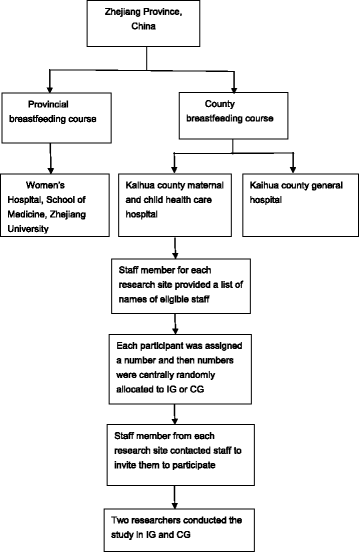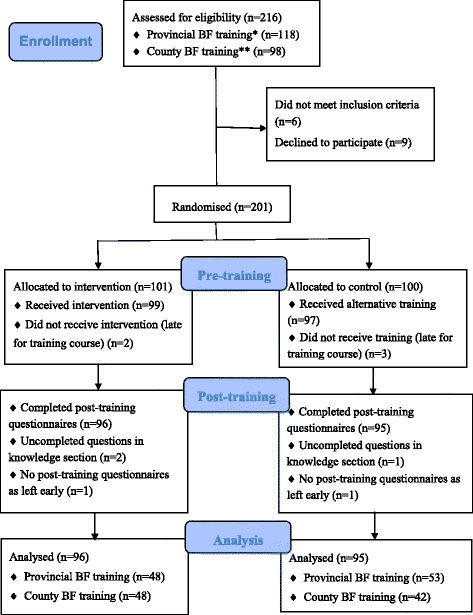A randomised controlled trial of the effectiveness of a breastfeeding training DVD on improving breastfeeding knowledge and confidence among healthcare professionals in China
- PMID: 29587673
- PMCID: PMC5869775
- DOI: 10.1186/s12884-018-1709-1
A randomised controlled trial of the effectiveness of a breastfeeding training DVD on improving breastfeeding knowledge and confidence among healthcare professionals in China
Abstract
Background: Despite almost all babies being breastfed initially, the exclusive breastfeeding rate at six months is less than 30% in China. Improving professionals' knowledge and practical skill is a key government strategy to increase breastfeeding rates. This study aimed to test the effectiveness of a breastfeeding DVD training method for clinicians on improving their knowledge and confidence in the breastfeeding support skills of teaching mothers Positioning and Attachment (P & A) and Hand Expression (HE).
Methods: A randomised controlled trial was conducted in three hospitals in Zhejiang province, China in 2014. Participants were recruited before their routine breastfeeding training course and randomly allocated to intervention group (IG) and control group (CG). The 15 min "Breastfeeding: Essential Support Skills DVD" was the intervention for IG and a vaginal delivery DVD was used for CG. All participants completed questionnaires of job information, knowledge and confidence in the two skills before (baseline) and immediately after viewing the DVD (post DVD).
Results: Out of 210 participants, 191 completed knowledge assessments before and after watching the DVD (IG n = 96, CG n = 95), with the response rate of 91.0%. At baseline, there are no significant differences in job variables, total knowledge scores and confident scores. The total knowledge score significantly increased post-DVD for IG (pre-DVD: M = 5.39, SD = 2.03; post-DVD: M = 7.74, SD = 1.71; t (95) = - 10.95, p < 0.01), but no significant change in total knowledge score for CG between pre- and post-DVD (pre-DVD: M = 5.67, SD = 1.70; post-DVD: M = 5.56, SD = 1.63; t (94) = 0.85). The total confidence scores were significantly higher post-DVD than pre-DVD in IG (pre-DVD: M = 66.49, SD = 11.27; post- DVD: M = 71.81, SD = 9.33; t (68) = - 4.92, p < 0.01), but no significant difference was seen in CG between pre- and post-DVD total confidence scores (pre-DVD: M = 68.33, SD = 11.08; post-DVD: M = 68.35, SD = 11.40; t (65) = - 0.25). Personal and job variables did not mediate these effects.
Conclusions: The breastfeeding training DVD improved professionals' knowledge and confidence of the two breastfeeding support skills. However, the effect on professionals' practice and on breastfeeding outcomes needs to be examined in the future.
Keywords: Attachment; Breastfeeding; DVD; Hand expression; Maternity services; Midwives; Nurses; Positioning; Training.
Conflict of interest statement
Ethics approval and consent to participate
The study was given ethical approval by Coventry University, UK (ref: P5842), and Zhejiang University, China (ref: 20120002). All the participants were provided with the participant information sheet and signed the consent forms to participate in the study.
Consent for publication
Not applicable.
Competing interests
The authors declare that they have no competing interests.
Publisher’s Note
Springer Nature remains neutral with regard to jurisdictional claims in published maps and institutional affiliations.
Figures
References
-
- Popkin BM, Adair L, Akin JS, Black R, Briscoe J, Flieger W. Breast-feeding and diarrheal morbidity. Pediatrics. 1990;86(6):874–882. - PubMed
-
- Khan J, Vesel L, Bahl R, Martines JC. Timing of breastfeeding initiation and exclusivity of breastfeeding during the first month of life: effects on neonatal mortality and morbidity—a systematic review and meta-analysis. Matern Child Health J. 2014;19:468–479. - PubMed
Publication types
MeSH terms
Grants and funding
LinkOut - more resources
Full Text Sources
Other Literature Sources
Medical



